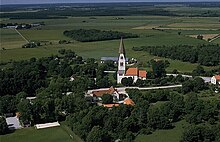Church of Rone
The Church of Rone ( Swedish Rone kyrka ) is a country church from the 14th century on the Swedish island of Gotland . It belongs to the parish (swed. Församling ) Alva, Hemse och Rone församling in the diocese of Visby . Since the Middle Ages , the church has been named Lang Jaku after its patron saint James and because of its high church tower, which is a landmark for seafarers .
location
The church is 49 km south of Visby , 5 km southeast of Hemse and 22 km north of Burgsvik near the coast in the south-eastern part of Gotland.
Church building
Some preserved reliefs and base stones testify to an earlier Romanesque stone church. Today's plastered church consists of a two-aisled nave , a church tower in the west and a narrower, just closed choir in the east, to which a sacristy is attached in the north . The building material is limestone with an impact of sandstone and granite . The church stands on the border between the sandstone area in the south of Gotland and the limestone area on the rest of the island. There are details of fine carved stone. The nave, the choir with the sacristy and the lower part of the tower were built around 1300. The tower was completed in the middle of the 14th century under the guidance of the master stonemason "Egypticus" . The exterior is dominated by the church tower with galleries in three directions. It has pointed arched sound hatches with columns, pointed gables and an octagonal spire on two floors. The church's window openings are still original. The nave has narrow pointed arch windows, the choir has a round window in the south and a group of three connected east windows. Of the four medieval portals, the two perspective portals in the south of the choir and nave stand out with their finely carved capital bands . The nave portal was partially renewed in 1915 and 1955. The nave and the chorus are from the outside with pitched roofs covered, while the Sakristei a pent roof has. Inside the nave is covered by four cross vaults, which are supported by a slender central column with ornaments near the capital and strong arches cut from limestone that run across the vault. The pointed arched tower arch leads to the tower room (bell chamber), and a likewise pointed arched triumphal arch leads to the choir. The vault paintings are from around 1300, while the wall paintings of the nave were done by the Passion Master in the mid-15th century . The stained glass from the middle of the 13th century are still preserved in the choir. The church has an unusually rich post-Reformation institution. It was restored from 1954 to 1955 according to plans by the architect Eiler Græbe .
Furnishing
- In the triumphal arch hangs a sculpture of Jesus on the cross surrounded by Mary and John . The crucifixion scene was made on Gotland around 1400.
- The church bell is the oldest dated on Gotland that is still working. On the bell is the inscription: I Herrens år 1345 blev jag gjuten i Hemse. Fader var nådig mot prästernas gemenskap och den betryckta staden ("In the year of the Lord 1345 I was cast in Hemse . Father be gracious to the community of priests and the oppressed city").
- A medieval choir robe is on display in the sacristy.
- The pulpit is dated according to inscription on 1595 and one of the oldest canopies and the stairs are from the 1664th
- The sandstone font was made in 1664 and replaced a font from the 12th century, made by master Hegvald .
- The sandstone altar was made by Peiter van Eigen in 1694 .
- The organ was built in 1876 by Åkerman & Lund Orgelbyggeri from Stockholm and renovated in 1988 by J Künkels Orgelverkstad from Färjestaden.
- The choir organ was built in 1988 by J Künkel .
Sources and information
literature
- Våra kyrkor. Klarkullens förlag, Västervik 1990, ISBN 91-971561-0-8 , p. 692 (Swedish).
Web links
- guteinfo (Swedish, with pictures)
- PaGotland ( Memento from August 30, 2010 in the Internet Archive ) (Swedish)
- Orgelanders (Swedish, with pictures)
- Webbgalleri Gotland (Swedish, with pictures)
- Building register at the Riksantikvarieämbetet (Swedish, free material, from which the original Swedish article was partially obtained)
- Alva, Hemse och Rone församling (Swedish, parish side)
Coordinates: 57 ° 12 ′ 32.3 " N , 18 ° 26 ′ 28.8" E


